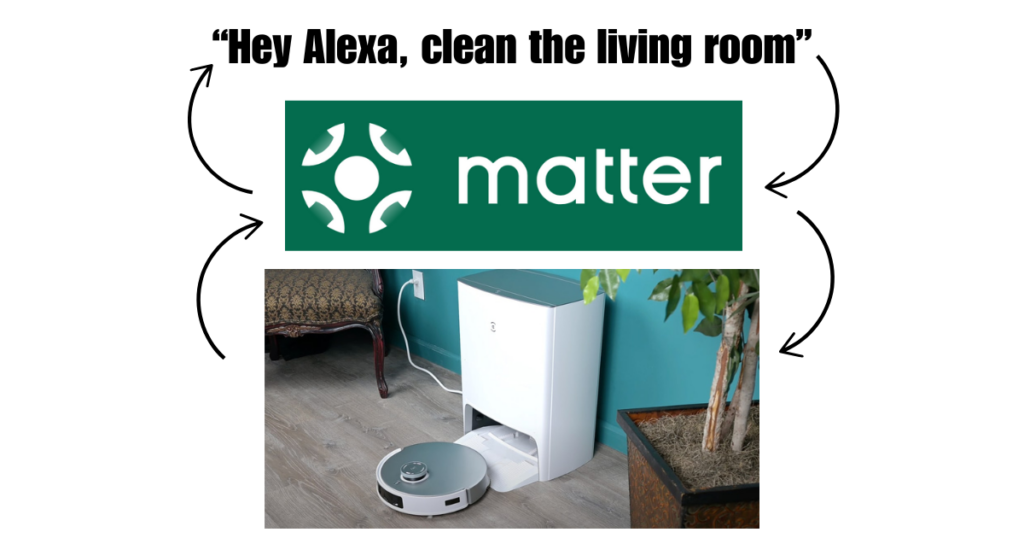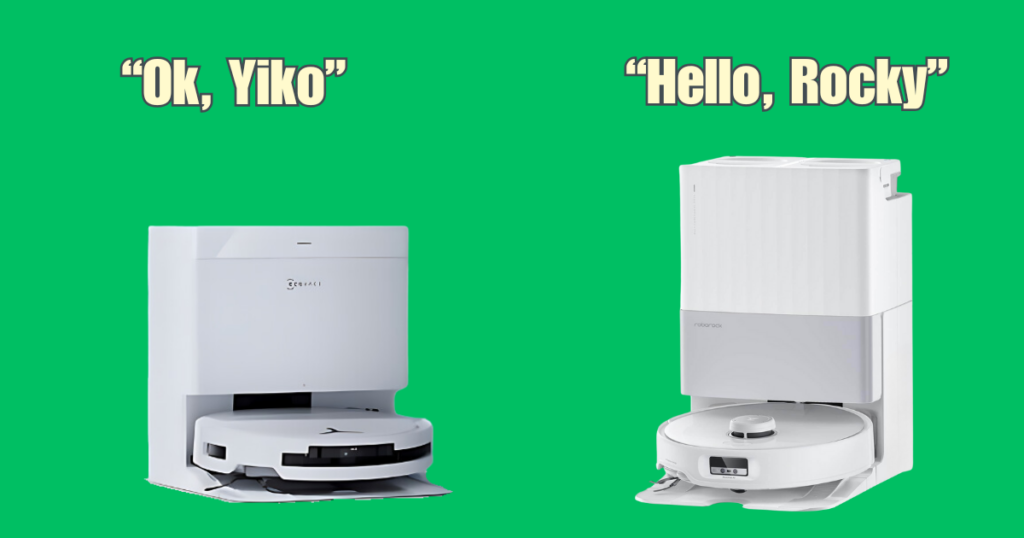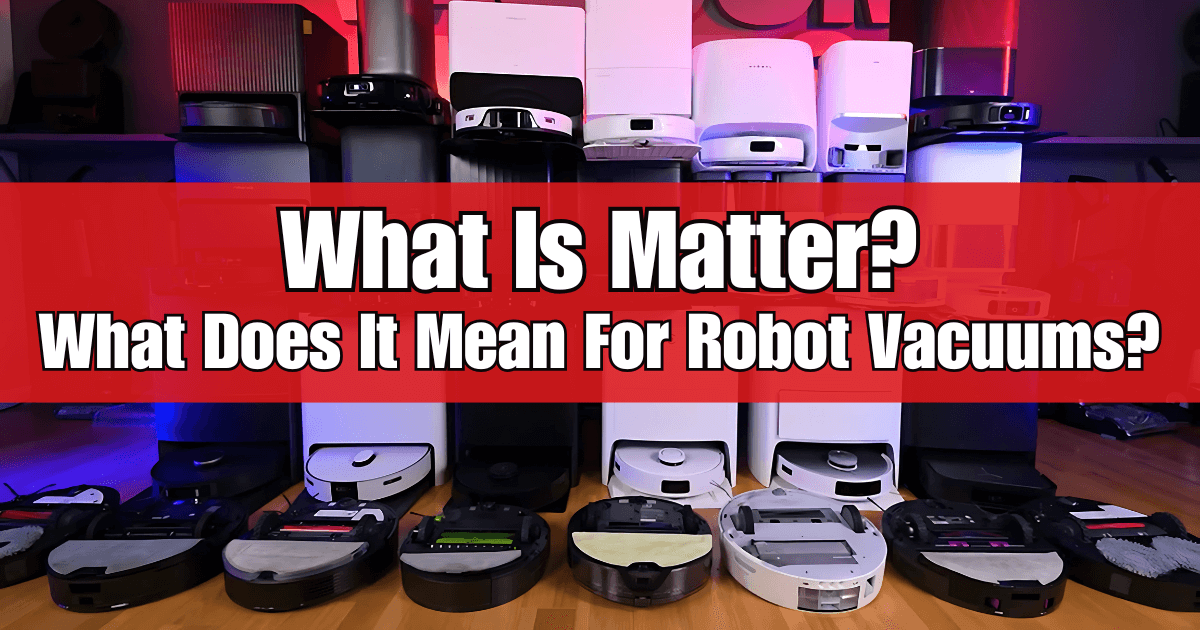The landscape for robot vacuum owners is more exciting and complex than ever. On one side, the Matter protocol promises to unify different brands and simplify interoperability, while major platforms such as Amazon Alexa, Google Home, and Apple Home continue expanding their AI capabilities. Roborock made a splash when they joined the CSA last year and announced Matter compatibility with its new Saros series. Meanwhile, manufacturers are venturing into native voice assistants, aiming to deliver hands-free cleaning commands without relying on an external service.
There have been reports of progress and setbacks as these technologies roll out [1][2][3][4][9], but for some of us, the question remains: what is it we’re waiting for, exactly?
In this article, we explore how these developments tie together for robot vacuum owners: what Matter is, why it’s important to robot vacuums, how it integrates with voice ecosystems, and how next-generation AI could eventually transform the way you talk to your vacuum.
What Is the Matter Protocol?
The Matter protocol is a universal smart home standard under the Connectivity Standards Alliance (CSA). It has broad industry backing from Apple, Amazon, Google, Samsung, and more. Originally set to launch in 2021, the official release was postponed to late 2022 due to the scope and complexity of aligning so many stakeholders [3].
Its goal is to provide a common language so smart home gadgets—from light bulbs to robot vacuums—can discover and communicate with each other over a local network. Users will discover their device on their Matter controller (Alexa, or Google Home, or whatever their hub of choice is). From there, the device would have out-of-the-box functionality through Matter from the controller hub.
Key Features of Matter
- Local Connectivity: Emphasizes direct LAN communication (via Ethernet, Wi-Fi, or Thread), reducing reliance on cloud servers.
- Secure Onboarding: Uses encryption and device attestation certificates to verify each gadget’s authenticity.
- Multi-Admin Support: Allows a single device (like a robot vacuum) to be controlled by multiple Matter-compatible apps [5].
- Common Data Model: Gives each device type—lamps, locks, vacuums—a standard set of commands so they work consistently across ecosystems.
How Voice Ecosystems Work with Matter
Voice platforms like Amazon Alexa, Google Home, and Apple Home serve as the user interface for your smart home. When you speak a command, these systems process your voice through the cloud and then send the command to your device. Matter acts as the common language that lets your devices talk to each other over your local network. This means that when you tell Alexa or Google Home to “start cleaning,” your Matter‑compatible vacuum receives the command directly over Wi‑Fi, even if your internet is down.[2]
Thanks to Matter’s multi‑admin feature, once you set up your vacuum, you can control it from any Matter‑compatible device or app. Whether you use a Google Home speaker or an Apple Home app (with its upcoming version that includes robot vacuum compatibility), your vacuum will respond the same way without needing separate setups for each system.

What Problem Does Matter Solve?
While many robot vacuums already work with Alexa or Google Home, Matter is designed to solve some underlying challenges. Matter isn’t just another way to issue voice commands—it makes your smart home devices “speak the same language.” This means:
- Universal Control Across Devices:
With Matter, you can control devices from different brands using one hub. Imagine having a robot vacuum from one company, smart lights from another, and a thermostat from a third—all working together seamlessly. Instead of relying on separate manufacturer apps or “skills” (which are voice extensions that have to be manually set up to let Alexa or Google control a specific device), Matter lets you set up your vacuum once and then control it from any Matter‑compatible system. This standardization means you won’t need to juggle multiple setups. - Reliable Operation Even During Internet Outages:
Matter’s local-first design allows your devices to communicate directly on your home network. If your internet goes down, your robot vacuum can still understand simple commands like “start cleaning” because it doesn’t have to rely on sending your voice to the cloud for processing. - Simplified Setup and Consistent Features:
Once your Matter‑enabled device is onboarded, it appears in every Matter‑compatible app automatically. This “multi‑admin” feature means you can control your vacuum from any system without the need to enable separate skills or custom integrations for each platform. Moreover, Matter standardizes core functions—like starting or stopping the vacuum, switching cleaning modes, and reporting status—so you get consistent performance regardless of which ecosystem you’re using.
While Alexa and Google Home already offer control for many robot vacuums, Matter is supposed to improve the overall experience by allowing devices from any brand to work together, remain responsive even without internet access, and provide a more unified control system.
Expected User Experience with Matter
From a consumer standpoint, the promise of Matter is a more unified smart home. You could purchase a Matter-certified robot vacuum, set it up via a single QR scan, and watch it automatically populate in all your preferred apps—such as Google Home or the upcoming version of Apple Home—without juggling brand-specific logins or skill setups.
A “skill” is essentially a voice extension that you add to a voice assistant like Amazon Alexa, and these need to be set up manually. Skills enable additional functionality—such as controlling a specific brand of robot vacuum. For example, if a robot vacuum doesn’t have an on-board voice assistant, you might need to enable a dedicated “Roomba skill” on Alexa, which acts as an intermediary to interpret your commands and control the vacuum. Matter would be expected to eliminate this set up.
Despite this promise, there have been hold-ups. Apple recently delayed official vacuum support in the Home app until sometime in 2025 [4]. Meanwhile, many older vacuums will not receive Matter firmware updates if their internal hardware can’t handle the new protocols. Additionally, broad interoperability sometimes introduces security considerations: if a single device is compromised, it might theoretically provide an entry point to other connected gadgets, urging manufacturers to enforce rigorous security standards [2].
Another complication is the fact that Matter does not eliminate the need for multiple apps. Even Matter compatible devices need manufacturer apps for set-up, as Matter cannot support mapping your home. You still need both a voice ecosystem AND a designated device app, which some have pointed out throws the whole promise behind Matter into question. [5] The fragmentation of device manufacturers and proprietary apps frustrates the problem. Yet consumers and tech enthusiasts alike are hopeful for a day when they can set-up a goodnight routine that dims the lights, turns down the thermostat, and washes the floors with a single command.

Native Voice Assistants in Robot Vacuums
A growing trend is to include onboard voice assistants directly in robot vacuums. This approach aims to let you speak basic commands—like “start cleaning” or “go back to the dock”—without a separate smart speaker. For instance, Roborock’s “Hello Rocky” and Ecovacs’ “OK YIKO” can interpret limited voice commands on-device [6]. The advantage is offline functionality: even if your internet is down, you can still ask the vacuum to start or stop.
However, these embedded systems tend to lack the sophistication of platforms such as Alexa or Google Assistant. They support fewer natural language variations, and they can occasionally misinterpret wake words or commands, especially if the vacuum’s motor is running or the environment is noisy. Some users find them helpful for quick tasks, while others see them as novelty features. Over time, though, improvements in AI chipsets and local processing could bring these vacuum-based assistants closer to the capabilities of mainstream voice ecosystems.
How It Comes Together for Robot Vacuum Control
So, we have Matter, voice-controlled ecosystems, and native voice assistants. Here’s how the pieces come together:
- Matter as the Connectivity Backbone:
Matter acts as a common language for smart home devices. It allows devices from different manufacturers to communicate directly over your local network. For your robot vacuum, this means that once it’s Matter‑certified, it can exchange information with other Matter-enabled devices (like smart lights, thermostats, and locks) without needing separate, brand‑specific integrations. Whether you’re issuing a start/stop command or checking its battery status, Matter will allow your vacuum to speak the same language as your other devices, making control more straightforward. - Voice Ecosystems (Alexa, Google Home, Apple Home, Samsung SmartThings, etc.):
These platforms provide the voice control and automation layer for your smart home. When you speak to your Alexa, Google Home, or Apple Home device, your voice command is processed without going through the cloud and translated through Matter into an instruction that your robot vacuum can understand. For example, you might say, “Hey Google, start cleaning.” The Google Home system interprets your request, and because your robot vacuum is Matter‑compatible, the command is sent directly over your local network. - Native Voice Assistants in Robot Vacuums:
Some robot vacuums come with built‑in voice assistants that allow you to control them directly. These native assistants are designed for basic functions—such as starting, stopping, or returning to the dock—and often work offline by processing commands on the device itself. Even if you don’t use a separate voice assistant like Alexa or Google Home, the built‑in system provides an alternative way to interact with your vacuum.
The dream: Imagine a scenario where, after detecting that everyone has left home, your smart home automatically dims the lights and sets your thermostat to an energy-saving temperature. At the same time, the robot vacuum starts cleaning. All these actions could be coordinated in one routine using Matter.
That kind of integration is one reason Matter is so attractive, even though we still don’t know if the promise will be delivered in its first iterations.
Considerations for Robot Vacuum Customers
- Confirm Matter Support: If you want the freedom to switch between Alexa, Google, or Apple, look for vacuums officially planning to adopt Matter. Firmware updates may be pending for some existing models, but not guaranteed for all.
- Evaluate Your Ecosystem: If you’ve already invested in Alexa devices, Amazon’s generative AI revamp (now expected in 2025) could significantly enhance your voice control experience, including your robot vacuum [1]. Google users may see similarly advanced features through Assistant with Bard, while Apple’s official vacuum controls are still delayed as of this writing [4].
- Consider Native Voice: Built-in vacuum assistants can be handy for offline use but typically offer fewer commands and less “intelligence” than mainstream platforms. That may change if on-board AI tech progresses, but it’s too soon to say.
- Security and Privacy: While Matter’s local communication is a plus, it also underscores the importance of device security patches. If you’re concerned, check what data your vacuum sends and where.
⚠️ It is important to note that Matter will not remove the need for dedicated manufacturer apps. Matter cannot support mapping with smart home hubs, so a specialized app will be still necessary for set up. [8]
⚠️ Apple’s iOS 18.4 supports robot vacuums through Matter. Roborock’s April 2025 firmware update enables support for select Roborock models on Apple Home.
Matter-Compatible Brands and Models
These models are either fully certified with Matter out of the box, or they are designed with Matter support or to receive Matter updates over the air (OTA) as they are released.
⭐ Update: Between April 1-10, 2025 Roborock releases its firmware updates to enable Matter on Matter-Compatible devices.
| Brand | Matter-Compatible Model(s) | Matter Compatibility Details | Source |
|---|---|---|---|
| Roborock | S8 MaxV Ultra, Qrevo Master, Qrevo Curv, Qrevo Edge, Saros 10, Saros 10R, Saros Z70 (upcoming) | Fully Matter‑certified; supports core functions (start/stop, cleaning modes, status updates) via OTA upgrades. | The Verge |
| Ecovacs | Deebot X2 Combo, Upcoming: X8 Omni, X8 Pro Omni, T50 Omni, T50 Pro Omni | Developed with Matter 1.4 support to enable remote control and notifications | HomeKit |
| SwitchBot | S10, K10+, K10+ Pro, and the announced S20 Pro and K20+ Pro | Offers Matter support over Wi‑Fi, allowing integration with Apple Home, Google Home, and Alexa without needing third‑party bridges. | The Verge |
| iRobot | Roomba Combo 10 Max | A CSA member, iRobot is expected to extend Matter support via firmware updates and new models | Matter Alpha |
| Dreame | X40 Ultra | Anticipated Matter support through future updates, aligning with the protocol’s expansion to additional device types. | The Verge |
| TP‑Link / Midea | TP‑Link RV20 Max, TP‑Link RV30 Max, Midea J15 | Listed on MatterAlpha’s product pages as Matter‑compatible; expected to function with core Matter commands for device control. | Matter Alpha |
| Eufy | Omni S1 | Matter compatibility is rumored but not confirmed | Matter Alpha |
Looking to the Future with Advanced AI (Pi0 and Beyond)
Generative AI is rapidly reshaping voice assistants. Amazon is planning a major upgrade to Alexa, enabling more natural, multi-turn conversations powered by large language models, but the update has faced internal delays [1]. Google is taking a similar tack with “Assistant with Bard,” blending LLM-driven reasoning with voice commands, while Apple is rumored to be exploring its own advanced language model offerings.
For robot vacuums, these developments hint at a future where you can say, “Please vacuum the living room at 3 p.m. if you detect no one is home—otherwise wait until 5 p.m.,” and the system could handle that logic. Projects like Pi0 (Pi-zero) go a step further, envisioning a fully natural language interface that can interpret multi-step instructions and even ask follow-up questions for clarification [7]. While these advanced AI features are mostly cloud-based now, hardware acceleration could eventually allow on-device interpretation—blending the convenience of offline native voice with the intelligence of generative AI.
FAQ: Understanding Matter and Robot Vacuums
What is Matter and why should robot vacuum owners care?
Matter is a universal smart home standard developed by the Connectivity Standards Alliance (CSA) with support from Apple, Amazon, Google, and others. It enables different brands of smart devices—including robot vacuums—to communicate over a local network using the same language. For vacuum owners, this means easier setup, more reliable operation (even without internet), and the ability to control their devices from any Matter-compatible platform, regardless of brand.
How does Matter improve the voice control experience with vacuums?
Matter enhances voice control by allowing robot vacuums to receive commands directly from voice assistants like Alexa, Google Home, or Apple Home, over your local Wi-Fi network. This eliminates the need for separate “skills” or brand-specific integrations. Thanks to Matter’s multi-admin support, you can control your vacuum from multiple apps without reconfiguring it each time.
Can I control my Matter-compatible vacuum without the internet?
Yes. One of Matter’s key advantages is its local-first design. This means your smart devices, including robot vacuums, communicate on your home network without needing cloud access. So if your internet goes down, you can still issue simple commands like “start cleaning” via supported voice platforms or built-in voice assistants.
What are native voice assistants in robot vacuums, and how are they different?
Native voice assistants—like Roborock’s “Hello Rocky” or Ecovacs’ “OK YIKO”—are built directly into the vacuum. They allow you to give basic commands (e.g., start, stop, return to dock) without using an external smart speaker. While useful for offline control, they tend to support fewer commands and are less sophisticated than cloud-based assistants like Alexa or Google Assistant.
Is Matter support available on all robot vacuums now?
No. Matter support is still rolling out. Only select newer models from brands like Roborock, Ecovacs, SwitchBot, and Dreame are currently Matter-compatible, often through firmware updates. Older models may not receive updates if their hardware can’t support the protocol. It’s important to check a vacuum’s specs and brand announcements before buying if Matter compatibility is important to you.
End Notes
- Reuters, “Amazon’s AI revamp of Alexa assistant nears unveiling,” 2024.
https://www.reuters.com/technology/amazon-set-release-long-delayed-alexa-generative-ai-revamp-2025-02-05/ - Forbes Tech Council, “From Chaos to Clarity: How the Matter Protocol Brings order to the Smart Home Ecosystem,” 2024.
https://www.forbes.com/councils/forbestechcouncil/2024/01/08/from-chaos-to-clarity-how-the-matter-protocol-brings-order-to-the-smart-home-ecosystem/ - Stacey on IoT, “Does it Matter? Smart home standard is delayed until 2022,” 2022.
https://staceyoniot.com/does-it-matter-smart-home-standard-is-delayed-until-2022 - Vacuum Wars, “Apple Delays Robot Vacuum Control Feature for Home App,” 2024.
https://www.vacuumwars.com/articles/apple-delays-robot-vacuum-control - IoT For All, “Why the Matter Protocol Hasn’t Lived Up to Its Promise,” 2023.
https://www.iotforall.com/why-the-matter-protocol-hasnt-lived-up-to-its-promise - Wired, “Review: Deebot X1 Omni,” 2022. https://www.wired.com/review/ecovacs-deebot-x1-omni/
- Physical Intelligence, “Our First Generalist Policy – Pi0,” 2024. https://www.physicalintelligence.com/blog/pi-0
- The Verge – https://www.theverge.com/23568091/matter-compatible-devices-accessories-apple-amazon-google-samsung
- Tom’s Guide – https://www.tomsguide.com/home/smart-home/whats-the-matter-with-matter-after-2-years-this-promising-smart-home-protocol-has-stalled




